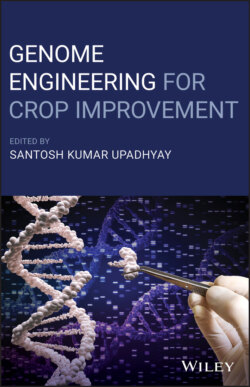Читать книгу Genome Engineering for Crop Improvement - Группа авторов - Страница 18
1.3 TALENs
ОглавлениеTranscription activator‐like effectors nucleases (TALENs) are fusion proteins, consisting of a DNA‐binding domain and a DNA‐cleavage domain. Whereas the DNA‐cleavage domain is the same between zinc‐finger nucleases and TALENs (the catalytic portion of FokI), the DNA binding domains are different. The TALEN DNA‐binding domain is derived from TALE proteins found in the plant pathogen Xanthomonas. These proteins are composed of direct repeats of 33–35 amino acids, and nearly all arrays found in Xanthomonas contain a final, half repeat, consisting of the first 20 amino acids from the normal repeat. Two amino acids within these repeats (positions 12 and 13) are responsible for recognizing a single nucleotide base (these amino acids are referred to as repeat‐variable diresidues; RVDs). When the TALE effector code was broken (i.e. the relationship between the RVD and corresponding target base) (Boch et al. 2009; Moscou and Bogdanove 2009), the ability to redirect targeting, and their use as a genome engineering tool was realized (Christian et al. 2010; Li et al. 2011; Mahfouz et al. 2011). To make TALENs useful in gene targeting, the basic requirement is the modular assembly of repeat sequences containing the appropriate RVD corresponding to the nucleotide target. The most widely used RVDs and their nucleotide targets are HD, cytosine; NG, thymine; NI, adenine; NN, guanine, and adenine; NS, adenine, cytosine, and guanine; N*, all four nucleotides. This one‐to‐one correspondence of a single RVD to a single DNA base has eliminated construction challenges due to context‐dependency seen with zinc‐fingers and meganucleases. However, one limitation when using TALENs is that the target sequence must have thymine at the −1 position (Boch et al. 2009). Further, the long and repetitive nature of TALENs puts a strain on delivery methods where cargo capacity or stability is a limitation.
The assembly of engineered TALE repeat arrays can be challenging from nearly similar repeat sequences; therefore, a number of platforms have been designed to facilitate this assembly. These can be classified into three categories: standard restriction enzyme and ligation‐based cloning methods (Huang et al. 2011; Sander et al. 2011); Golden Gate assembly methods (Briggs et al. 2012; Cermak et al. 2011; Engler et al. 2008) and solid‐phase assembly methods (Heigwer et al. 2013; Wang et al. 2012).
Several online tools are available for designing TALE effectors to target specific gene sequence and off‐target analysis. For example‐ E‐TALEN (Lin et al. 2014), Scoring Algorithm for Predicting TALEN Activity (SAPTA) (Neff et al. 2013), Mojo‐hand (Coordinators 2013), TAL Effector‐Nucleotide Targeter (TALE‐NT), etc. TALE‐NT is a collection of versatile web‐based tools like‐TALEN Targeter, TAL Effector Targeter, Target finder, Paired Target Finder, and TALEN Targeter Off‐Target Counter (Christian et al. 2013).
Several studies have demonstrated the usefulness of TALENs in different plant species, including Arabidopsis (Zhang et al. 2013), tobacco (Wang et al. 2012; Wendt et al. 2013), barley (Li et al. 2012), rice (Shan et al. 2013a) and Brachypodium (Reyon et al. 2011). Taken together, the modular nature of TALE repeats, along with efficient methods for assembling repetitive DNA sequences (Garneau et al. 2010; Wang et al. 2012), have enabled TALENs to become one of the premier tools for plant genome engineering.
